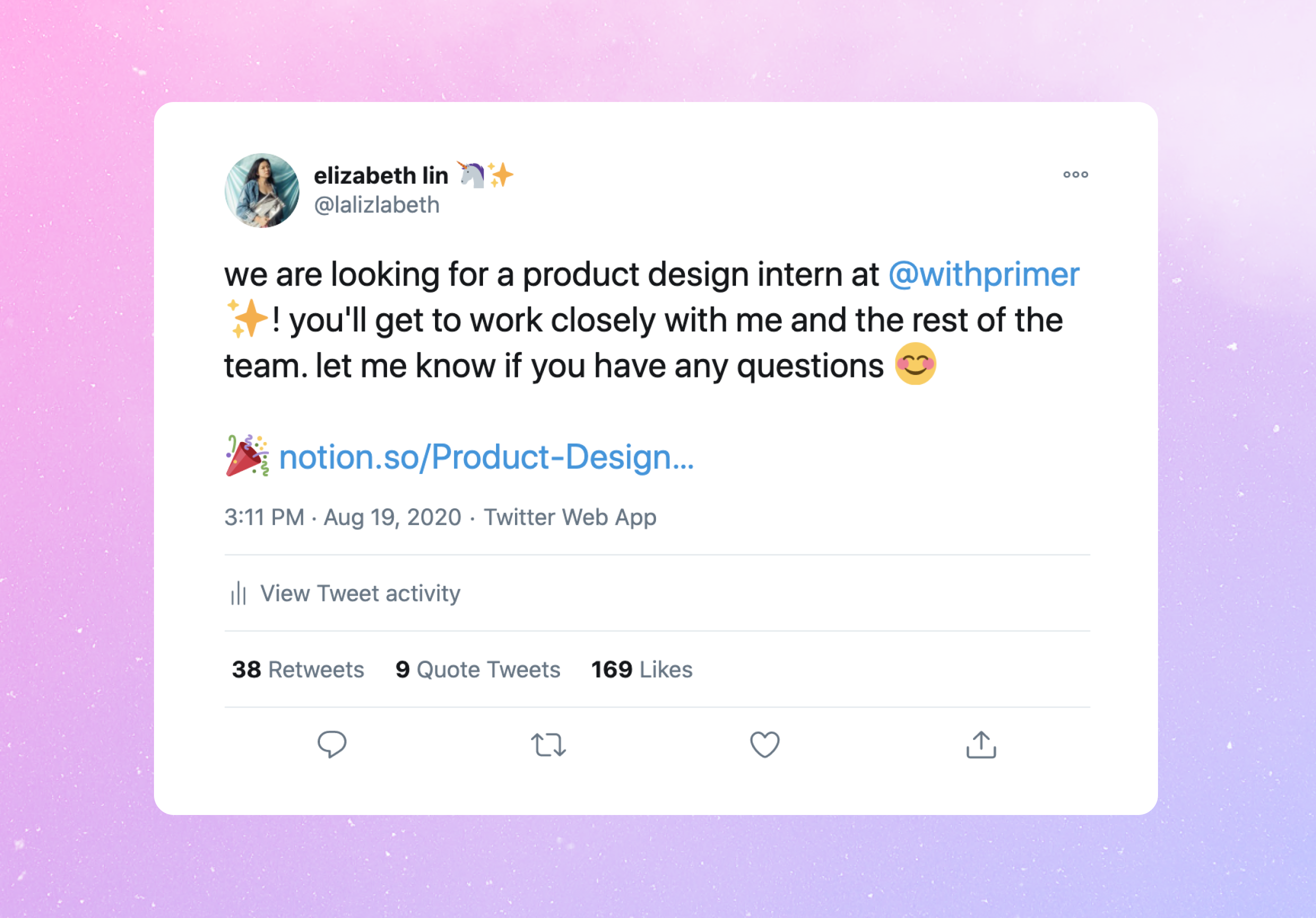I recently started at Primer as their founding designer! One of the first things I did was open a product design internship opportunity for emerging designers because internships were crucial to starting my career. I wanted to create an opportunity that was open to anyone regardless of school status and experience. Unfortunately, many design internships today are limited to students enrolled in a degree program or candidates who have previous design experience 🥺

For this role, I explicitly did not include requirements for previous experiences. Instead, I focused on describing the specific skills and work needed for the internship. I wanted to be clear that a candidate's portfolio of work would be the most important part of their application. Compared to other product design internships, I required a higher understanding of visual design because the design system and brand style at Primer are so nascent. This is an excerpt from the "About you" section of our job description:
- You have a strong portfolio with 2-3 case studies showcasing your process from problem definition to high-fidelity designs. We recommend reading this resource on design portfolios before you apply.
- You have a solid understanding of visual design: typography, color, and layout.
- You are comfortable using design tools and can design components from scratch. (We use Figma!)
- You are a great communicator and storyteller.
- You are comfortable working with ambiguity in fast-paced environments.
- You are self-driven and excited to learn.
We received nearly ✨ 400 applications ✨ without using job listing platforms like LinkedIn or Indeed. I only shared the job post on social media and directly with bootcamp grads and university students relying on word of mouth to pass the opportunity around. I was shocked by the number of applicants for a Fall internship at a 10-person startup. The large quantity of applicants suggests that the number of aspiring designers is increasing, but the opportunities aren't rising to match.

I'm really not very popular on Twitter, so 169 Likes and 38 Retweets was kind of a lot for a simple job posting.

Breaking into the design industry is difficult because of all the unspoken rules. Typically, the portfolio review process is opaque; reviewers rarely share what candidates need to work on. During our portfolio review process, I noticed that most candidates needed to improve upon the same two areas. Instead of sending a generic "You just weren't a good fit" letter, I wanted to provide insight into how applicants could improve their chances in the future. This is the rejection letter we sent to candidates who didn't make it to the phone screen:
Thank you for taking the time to apply for the Product Design Intern position at Primer. Unfortunately, we will not be moving forward with your application at this time.
When we reviewed portfolios, we looked for a couple things:
🎨 A solid understanding of visual design. At Primer, visual design is important because we are developing a new visual language from scratch. Our design library is just beginning, so we are looking for someone who is comfortable growing and pushing our design system forward.
- If you want to improve your visual design fundamentals, start with building an understanding of typography. Learn how to craft a type hierarchy that communicates with a minimum number of type styles. [See Talking Type by Jessica Hische / Thinking with Type by Ellen Lupton / Typography Checklist on design things]
- Make sure your resume exemplifies your visual design skills. Use a grid and optimize your type choices for readability.
📖 A cohesive story of your design process. Your design process should be different for every project. We looked for candidates who shared a unique design process from problem definition to high-fidelity designs. [See The Case Study Factory / Design Portfolios on design things]
- Share your case studies with a few non-designers. Make sure they can understand your design process. Avoid using design jargon.
- Connect the dots in your case studies. If you created a persona and never reference it in the rest of case study, then you probably didn't need a persona for your project 🧐.
- Surface iterations of your work at every step of the process. The first direction is never the best one. Explain how you used user research, usability testing, or design reasoning to make design decisions.
This is all general advice, but we hope this it's helpful for you in the future. We received an overwhelming number of applications for this role and wish you best of luck on your job search!
Emerging designers, this letter was specific to the product design intern position at Primer, but I believe that continuously improving in these two areas will open up more opportunities. Focus on developing your visual craft first because process is easier to develop through experience. Visual design will get you the interview, and your design process will land you the job. Out of the 400 applicants, we only selected 10 designers to phone screen. These 10 designers stood out in the sea of portfolios because of their visual craft.

Professional designers, if you're on a team that's hiring emerging designers, I encourage you all to reevaluate your job descriptions. Be specific about how you will review portfolios and give concrete ways that applicants can improve. Push your organizations to open opportunities for emerging designers regardless of their previous experiences.
This is just the start of Primer's design internship program and I am excited to continue growing the program in the future 💖